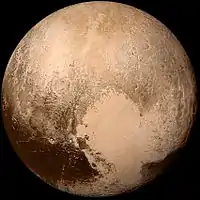MANTIS (spacecraft)
MANTIS (Main-belt Asteroid and NEO Tour with Imaging and Spectroscopy) is a mission concept that would flyby 14 asteroids covering a wide range of types and masses, and obtaining remote sensing and in-situ data. This mission would explore the diversity of asteroids to understand the Solar system's past history, its present processes, and hazards. The concept was proposed in 2019 to NASA's Discovery Program to compete for funding and development.[1]
| Mission type | Flyby of multiple asteroids |
|---|---|
| Operator | NASA |
| Orbital parameters | |
| Reference system | Heliocentric |
| Flyby of multiple near Earth asteroids and main belt asteroids | |
Overview
The MANTIS mission was first proposed to NASA's Discovery program in 2015, and it would have flown nine asteroids, but it was not selected at that time.[2] The concept was reformulated and proposed again in 2019.[1] The MANTIS mission would perform a flyby tour of near-Earth and Main belt asteroids as a means of observing several members of this population of objects, providing discovery science and also returning data that would be complementary and contextual to past, present, and future missions.[3]
The spacecraft would visit 14 asteroids, and would focus on members of eight known collisional families of different spectral classes and in different parts of the asteroid belt. The largest of these is 50 Virginia, an 85-km asteroid. [1] The current mission concept was formulated by a team composed of scientists from Johns Hopkins University Applied Physics Laboratory, NASA Goddard Space Flight Center, and the University of Colorado.[1]
Proposed payload
The proposed science payload includes four instruments: [3][1]
- a narrow-angle camera similar to that on board the New Horizons spacecraft and planned for inclusion on the Double Asteroid Redirection Test (DART) and Lucy spacecraft
- Near-infrared imaging spectrometer similar to the CRISM instrument on board the Mars Reconnaissance Orbiter
- a mass spectrometer analyzing microsamples shed by asteroids and interplanetary dust particles encountered during cruise.
- a mid-infrared camera measuring thermal emission and built by collaborators in the United Kingdom.
References
- "The Main-belt Asteroid and NEO Tour with Imaging and Spectroscopy (MANTIS)." Andrew S. Rivkin, Barbara A. Cohen, Olivier Barnouin, Carolyn M. Ernst, Nancy L. Chabot, Brett W. Denevi, Benjamin T. Greenhagen, Rachel L. Klima, Mark Perry, Zoltan Sternovsky, and the MANTIS Science Team. EPSC Abstracts Vol. 13, EPSC-DPS2019-1277-1, 2019 EPSC-DPS Joint Meeting 2019.
- Proposals to Explore the Solar System’s Smallest Worlds. Van Kane, The Planetary Society. 27 July 2015.
- The Main-belt Asteroid and NEO Tour with Imaging and Spectroscopy (MANTIS). Andrew Rivkin, Barbara A. Cohen, Olivier S. Barnouin, Nancy L. Chabot, Carolyn M. Ernst, Rachel L. Klima. AGU Fall Meeting 2018. Washington DC, 10-14 December 2018.





